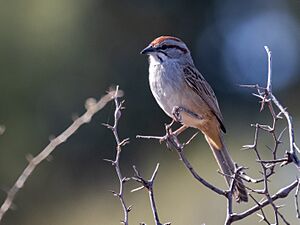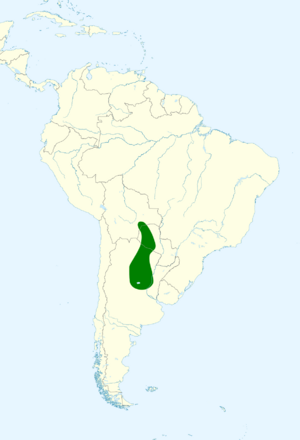Chaco sparrow facts for kids
Quick facts for kids Chaco sparrow |
|
|---|---|
 |
|
| Conservation status | |
| Scientific classification | |
| Genus: |
Rhynchospiza
|
| Species: |
strigiceps
|
 |
|
| Synonyms | |
|
Aimophila strigiceps |
|
The Chaco sparrow (Rhynchospiza strigiceps) is a small bird that lives in parts of Argentina and Paraguay. It belongs to the Passerellidae family, which includes many types of sparrows. This bird used to be known by a different name, the stripe-capped sparrow.
About Its Name
The Chaco sparrow has had a few name changes! It was once considered part of a larger group called the stripe-capped sparrow. Later, scientists decided it was different enough to be its own species. They also moved it into a new bird family group called Rhynchospiza.
In 2020, scientists officially separated it from another bird, the Yungas sparrow. This means the Chaco sparrow is now recognized as its own unique species.
What It Looks Like
The Chaco sparrow is a smaller bird. Its back and wings are light brown with darker stripes. It also has some rusty and gray colors mixed in. Its belly is pale gray, turning a bit buff (a yellowish-tan color) on its sides.
Its head is gray. It has a cinnamon-colored stripe on top of its head and another stripe behind its eyes. There's also a black stripe that looks like a mustache on its face.
Where It Lives
The Chaco sparrow lives in a region called the Gran Chaco. This area stretches from south-central Paraguay into north-central Argentina. The Gran Chaco is a low-lying place, usually less than 1,000 feet (300 meters) above sea level.
Its home is made up of dry forests and shrublands. These are special types of forests that don't get a lot of rain. The Chaco sparrow sometimes moves to different parts of this region depending on the season.
Its Song
The Chaco sparrow has a special song! It sings complex trills, which are fast, repeating sounds. This is different from the Yungas sparrow, which sings a series of chirps.
Its Status
The IUCN (International Union for Conservation of Nature) keeps track of how many animals are left in the wild. They have listed the Chaco sparrow as "Least Concern." This means that, for now, there are plenty of these birds, and they are not in danger of disappearing.



